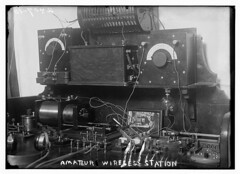I've made a WPAD server Fiddler extension and in a fit of creativity I've named it: WPAD Server Fiddler Extension.
Of course you know about Fiddler, Eric's awesome HTTP debugger tool, the HTTP proxy that lets you inspect, visualize and modify the HTTP traffic that flows through it. And on the subject you've probably definitely heard of WPAD, the Web Proxy Auto Discovery protocol that allows web browsers like IE to use DHCP or DNS to automatically discover HTTP proxies on their network. While working on a particularly nasty WPAD bug towards the end of IE8 I really wished I had a way to see the WPAD requests and responses and modify PAC responses in Fiddler. Well the wishes of me of the past are now fulfilled by present day me as this Fiddler extension will respond to WPAD DHCP requests telling those clients (by default) that Fiddler is their proxy.
When I started working on this project I didn't really understand how DHCP worked especially with respect to WPAD. I won't bore you with my misconceptions: it works by having your one DHCP server on your network respond to regular DHCP requests as well as WPAD DHCP requests. And Windows I've found runs a DHCP client service (you can start/stop it via Start|Run|'services.msc', scroll to DHCP Client or via the command line with "net start/stop 'DHCP Client'") that caches DHCP server responses making it just slightly more difficult to test and debug my extension. If a Windows app uses the DHCP client APIs to ask for the WPAD option, this service will send out a DHCP request and take the first DHCP server response it gets. That means that if you're on a network with a DHCP server, my extension will be racing to respond to the client. If the DHCP server wins then the client ignores the WPAD response from my extension.
Various documents and tools I found useful while working on this:
 Irritatingly out of line with what their commercials say, in my area Comcast, under the covers of the national
broadcast digital switch, is sneaking in their own switch to digital, moving channels above 30 to their own digital format. Previously, I had Windows 7 Media Center running on a PC with a Hauppauge PVR500 which can decode two television signals at once setup to record shows I like. The XBox 360 works
great as a Media Center client letting me easily watch the recorded shows over my home network on my normal TV.
Irritatingly out of line with what their commercials say, in my area Comcast, under the covers of the national
broadcast digital switch, is sneaking in their own switch to digital, moving channels above 30 to their own digital format. Previously, I had Windows 7 Media Center running on a PC with a Hauppauge PVR500 which can decode two television signals at once setup to record shows I like. The XBox 360 works
great as a Media Center client letting me easily watch the recorded shows over my home network on my normal TV.
Unfortunately with Comcast's change, now one needs a cable box or a Comcast digital to analog converter in order to view their signal, but Comcast is offering up to two free converters for those who'd like them. The second of my two free converters I hooked up to the Media Center PC and I got the IR Blaster that came with my Hauppauge out of the garage. I plugged in the USB IR Blaster to my PC, connected one of the IR transmitters to the 1st port on the IR Blaster, and sat the IR transmitter next to the converter's IR receiver. I went through the Media Center TV setup again and happily it was able to figure out how to correctly change the channel on the converter. So I can record now, however:




On the topic of made up words: I get made up words for made up things, but there's already a name for cell-phone in English: its "cell-phone". The narrator notes that the book has been translated into English so I guess I'll blame the fictional translator. Anyway, I wasn't bothered by the made up words nearly as much as some folk. Its a good thing I'm long out of college because I can easily imagine confusing the names of actual concepts and people with those from the book, like Hemn space for Hamming distance. Towards the beginning, the description of slines and the post-post-apocalyptic setting reminded me briefly of Idiocracy.
Recently, I've been reading everything of Charles Stross that I can, including about a month ago, The Jennifer Morgue from the surprisingly awesome amalgamation genre of spy thriller and Lovecraft horror. Its the second in a series set in a universe in which magic exists as a form of mathematics and follows Bob Howard programmer/hacker, cube dweller, and begrudging spy who works for a government agency tasked to suppress this knowledge and protect the world from its use. For a taste, try a short story from the series that's freely available on Tor's website, Down on the Farm.
Coincidentally, both Anathem and the Bob Howard series take an interest in the world of Platonic ideals. In the case of Anathem (without spoiling anything) the universe of Platonic ideals, under a different name of course, is debated by the characters to be either just a concept or an actual separate universe and later becomes the underpinning of major events in the book. In the Bob Howard series, magic is applied mathematics that through particular proofs or computations awakens/disturbs/provokes unnamed horrors in the universe of Platonic ideals to produce some desired effect in Bob's universe.
I'm a big fan of the concept of registerProtocolHandler in HTML 5 and in FireFox 3, but not quite the implementation. From a high level, it allows web apps to register themselves as handlers of an URL scheme so for (the canonical) example, GMail can register for the mailto URL scheme. I like the concept:
registerProtocolHandler("info:lccn/{lccnID}", "htttp://www.librarything.com/search_works.php?q={lccnID}", "LibraryThing LCCN")
I knew that the command line tool subst would create virtual drives that map to existing directories but I didn't know that subst lets you name the virtual drives with characters that aren't US-ASCII letters. For instance you can run 'subst 4: C:\windows' and then 'more 4:\win.ini' to dump C:\windows\win.ini. This also works for non-US-ASCII characters like, "C" (aka U+FF23, Fullwidth Latin Capital Letter C), which when displayed by cmd.exe via some best fit style character conversions looks just like the regular US-ASCII 'C'. None of Explorer, IE, or the common file dialogs allow the use of these odd virtual drives -- just cmd.exe, so I'm not sure how this would ever be useful but I thought it was odd and I wanted to share.

 The weekend before last Sarah and I went down to Gas Works Park in Seattle. Gas Works Park is a former Seattle Gas Light Company gasification plant now turned into a
park with the machinery kept intact and found right on the shore of Lake Union. There's a large hill right next to the plant with an embedded art installation from which you get an excellent view
of the park and the lake. Anyway a very cool place. Afer, we ate at Julia's of Wallingford where I stereotypically had the Santa Cruz
omelet. Good food, nice place, nice neighborhood.
The weekend before last Sarah and I went down to Gas Works Park in Seattle. Gas Works Park is a former Seattle Gas Light Company gasification plant now turned into a
park with the machinery kept intact and found right on the shore of Lake Union. There's a large hill right next to the plant with an embedded art installation from which you get an excellent view
of the park and the lake. Anyway a very cool place. Afer, we ate at Julia's of Wallingford where I stereotypically had the Santa Cruz
omelet. Good food, nice place, nice neighborhood.
 This past weekend was Halloween weekend. On Halloween at Microsoft parents bring their kids around the office buildings and collect candy from those who
have candy in their office. See Matt's photo of one such hallway at Microsoft. The next day Sarah and I went to two birthday parties the second of which required costume. I went as House (from the
television show House) by putting on a suit jacket and carrying a cane. Sarah wore scrubs to lend cred. to my lazy costume. Oh yeah and on Sunday Sarah bought a new car.
This past weekend was Halloween weekend. On Halloween at Microsoft parents bring their kids around the office buildings and collect candy from those who
have candy in their office. See Matt's photo of one such hallway at Microsoft. The next day Sarah and I went to two birthday parties the second of which required costume. I went as House (from the
television show House) by putting on a suit jacket and carrying a cane. Sarah wore scrubs to lend cred. to my lazy costume. Oh yeah and on Sunday Sarah bought a new car.
sequelguy posted a photo:
Immediately after Sarah took this photo, a truck pulled into the empty parking spot and the driver jumped out to apologize for messing up the photo. The driver was a zombie.